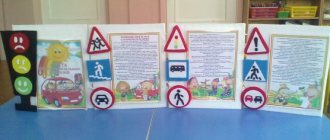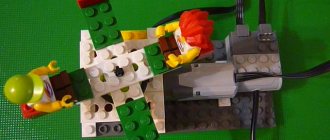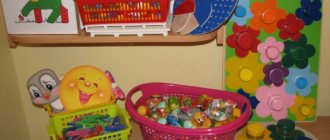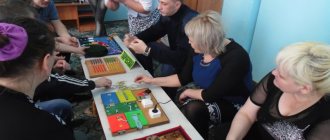What is a lapbook
A laptop is the newest way to organize educational activities with preschoolers. This is play, creativity, learning new things, repeating and consolidating what has been learned, systematizing knowledge, an interesting type of joint activity between the teacher and the child.
The meaning of a lapbook
The methodological manual Lapbook “Entertaining Mathematics” in secondary school was developed with the goal of children mastering mathematical methods of cognition, using educational games, in order to ensure the activity of mental and practical activity in the process of independent and joint activity of preschoolers and adults.
At the first stage, the child is taught to correctly navigate in space, that is, to react to the following moments: left, right, top, bottom, center, above, below, between, clockwise. Over time, the tasks become more difficult.
Note! Already in the fourth year, the child begins to solve addition/subtraction problems, and also consolidates the representation of a number from two smaller ones.
Math laptops
Contained in sections:
- Lapbook. Lapbooks on all topics 7360
- Mathematics. Mathematical representations, FEMP 33269
Showing publications 1-10 of 270. All sections | Mathematics. Math laptop
New
Photo
The best
Lapbook “Fun Math”
Annotation. Lapbook “Fun Math ”
intended for children of senior preschool age.
The laptop contains games and exercises aimed at developing elementary mathematical concepts in students. The laptop can be used both in the process of organizing...
Lapbook “Country of Mathematics”
Lapbook “Country of Mathematics ”
intended for primary preschool age.
It includes a variety of material that turns the introduction, study and repetition of mathematics by preschool children into an exciting game. This manual will help teachers in their work...
What should a math lapbook be like for preschoolers?
Spatial orientation is of universal importance for all aspects of human activity. This term includes various aspects of his interaction with reality. The human psyche is formed from this meaning.
Which math lapbook to choose for preschoolers
Note! Touching all areas of a preschooler’s interaction with any reality, spatial orientation has a beneficial effect on the child’s psyche. Already in the fourth or fifth year of life, the child develops self-awareness, as well as personal qualities. All these phenomena are part of the socialization process.
Lapbook for mathematics senior group is an assistant in:
- understanding and remembering information on the topic being studied;
- the child acquiring the skills to independently collect and organize information on the topic being studied;
- repetition and consolidation of material on the covered topic.
Psychological and pedagogical conditions for the implementation of the basic educational program of preschool education are one of the most important conditions. The teacher’s task is to develop children’s curiosity, their desire to explore this world. It is necessary to be able to choose adequate forms of pedagogical support for each child.
Play is the main and leading activity of preschool children. The preschool educational institution's laptop will help the teacher create conditions for free children's play. This manual is a visual and practical teaching method that meets modern requirements for organizing a subject-spatial developmental environment in the context of the implementation of the State educational standard for preschool education.
How to develop your child's self-confidence and strengthen his self-esteem
The educational institution believes that this teaching aid Lapbook “Entertaining Mathematics” is intended for children 4-6 years old.
Expected Result:
- increasing cognitive interest in children;
- effective assimilation of information and consolidation by students of what they have learned in an interactive, entertaining and playful form;
- development of mathematical and communication abilities.
Note! The novelty of the proposed manual is that the use of a lapbook ensures equality of opportunity and the full development of every child. By combining teaching and upbringing into a holistic educational process, a lapbook allows the teacher to build activities based on the individual characteristics of each child, to create conditions under which the child himself becomes active in choosing the content of his education.
For the older group
The main goal of this technique is to create all kinds of conditions so that they are aimed at the formation of spatial representations. During the work, children consolidate and expand their spatial representations: left, right, above, below, in front (in front, behind, next to), and also develop the ability to navigate on a sheet of paper. Every kindergarten teacher should teach preschoolers to indicate in speech the position of one or another object in relation to themselves and another object.
Senior group
Important! The educational program for the senior group is aimed at developing visual-spatial orientation in children. This leads to the development of speech, thinking, and intelligence.
For the middle group
A mathematics laptop for the preparatory group serves to form a logical-mathematical understanding, increase the activation of the thinking process, and develop sensory methods of cognition. For this purpose, kindergarten teachers use educational games. for example, you can consider a didactic game called “Learning numbers.”
Middle group
The main goal of the lesson for the fourth year is to introduce children to the images of numbers in poetry. They learn to understand, develop memory and thinking.
For the preparatory group
A laptop for FEMP in the preparatory group develops logical thinking, attention, and memory of the child. It is much easier to remember the material in a playful way. For example, a math lapbook on the topic “Mathematics Lives Here” is being considered. It acts as a house, which has a certain plot, including the main characters. Among them, “Numbers” stand out. The child's preschool age ranges from 4 to 6 years.
Preparatory group
The main goal is to repeat and consolidate the material covered in mathematics in a playful way. By solving problems on this topic, preschoolers’ knowledge of geometric shapes is improved, counting is consolidated up to 10. Special material is prepared for the work:
- colored paper,
- glue,
- plastic folder,
- satin ribbon,
- magnet,
- tulle,
- beads,
- foamiran.
Mathematics classes with children 3-4 years old at home and in kindergarten
Teaching aid: Lapbook “Fun Math”
“Complete the dots”
Purpose of the game:
— systematize children’s knowledge of numbers from 1 to 10;
— consolidate counting skills within 10;
- develop memory, attention, logical thinking, speech, creative abilities.
Game option: The child completes the image by dots with numbers sequentially from 1 to 10.
“Fun puzzles” (“Complete the drawing or cross out the excess”, “Count the objects”, “Fill in the missing number”).
Purpose of the game:
- learn to count objects, naming the final number;
- consolidate knowledge of numbers, correlate them with the number of objects.
Option 1: The child counts the objects. Crosses out the extra one or draws in the missing one so that the number of items equal to the number in this line is obtained.
Option 2: The child fills in the missing numbers in the line.
Option 3: The child connects the number and the corresponding number of objects with an arrow.
Section 2: “Geometric Shapes”:
"Geometric Lotto"
Purpose of the game:
-consolidate children’s knowledge about geometric shapes and colors;
- practice counting figures, regardless of shape and color;
- Develop children's memory,
the ability to compare figures and find signs of similarity;
- to activate vocabulary, speech, to develop intelligence, concentration, and quick thinking;
- develop joint gaming activities, be able to strictly follow the rules of the game.
Game option: The presenter distributes cards with a set of colored geometric shapes.
All figures are different colors without repetition. Next, the presenter takes out cards with a figure from the envelope. It is necessary to correctly and clearly name the figure and its color. The players, in turn, check their cards with a set of figures and look for the one that the leader named. The player who has such a figure takes the card for himself. The player who has collected all the cards wins.
"Appliqués from geometric shapes"
Purpose of the game:
— continue to introduce children to the technique of appliqué from geometric shapes;
— we teach how to do work based on existing ideas, teach children to compare the shape of objects with geometric figures;
- evaluate your own work and the work of your comrades.
Game option: The child performs an application of geometric shapes in accordance with the picture - example.
"Tangram"
Purpose of the game:
— to train children in the ability to carry out search actions of a mental and practical nature;
- create new images in the imagination based on the perception of schematic images;
- develop memory, attention, constructive thinking, intelligence;
- cultivate patience and perseverance.
Game option: The child draws a figure from the model - a picture, selects the necessary details, and names the resulting picture.
Lapbook for FEMP “Mathematics Lives Here” simulator (middle group)
The manual is intended for kindergarten teachers to systematize and consolidate children's acquired knowledge on the formation of elementary mathematical concepts. Can be used in joint and independent activities of preschoolers and adults, during individual work.
Relevance
A laptop is the newest way to organize educational activities with preschoolers. This is play, creativity, learning new things, repeating and consolidating what has been learned, systematizing knowledge, an interesting type of joint activity between the teacher and the child.
The methodological manual Lapbook “Mathematics Lives Here” was developed with the goal of children mastering mathematical ways of knowing, using educational games, in order to ensure the activity of mental and practical activity in the process of independent and joint activity of preschoolers and adults.
Tasks:
- Develop children's cognitive interests.
- Expand the experience of orientation in the environment.
- Develop sensory knowledge, mathematical properties.
- Develop curiosity and cognitive motivation.
- Develop perception, attention, memory, observation.
Originality
A laptop is of great importance for a teacher. It facilitates the organization of material on the topic under study within the framework of comprehensive thematic planning; promotes the organization of individual and independent work with children on the formation of elementary mathematical concepts.
For a child, a lapbook is an assistant in:
- Understanding and remembering information on the topic being studied.
- The child acquires the skills to independently collect and organize information on the topic being studied.
- Repetition and consolidation of material on the covered topic.
The teacher’s task is to develop children’s curiosity, their desire to explore this world. It is necessary to be able to choose an individual approach to children.
Play is the main and leading activity of preschool children. The laptop will help the teacher create conditions for free children's play. This manual is a visual and practical teaching method that meets modern requirements for organizing a subject-spatial developmental environment in the context of the implementation of the State educational standard for preschool education.
The methodological manual Lapbook “Mathematics Lives Here” is intended for children of senior preschool age.
The novelty of the proposed manual lies in the fact that the use of a lapbook ensures the full development of each child. A laptop allows a teacher to build activities based on the individual characteristics of each child, to create conditions under which the child himself becomes active in choosing the content of his education.
Description of the manual
The laptop contains 8 educational tasks:
- “Numbers” - familiarizing preschoolers with numbers, arranging them in the correct sequence, finding the missing ones, naming the neighbors of the numbers.
- “Compare the Numbers” - compare numbers using numbers or clothespins.
- “Counting backwards” - when turning pages, based on the recording of the number, the child counts forward and backward.
- “Write numbers correctly” is a sample for writing numbers correctly.
- “Labyrinths” is an interesting and intricate logic game that requires special concentration, patience and perseverance.
- “Drawing by numbers” - fixing the sequence of numbers.
- “Time of day” - fixing time periods based on the picture.
- “Days of the week” - helps the child learn the days of the week from pictures; using arrows of different colors, we introduce the concepts of “today”, “tomorrow” and “yesterday”.
Thanks to this visual and didactic manual, we are able to:
- Increase cognitive interest in children.
- Effectively assimilate information and reinforce the material learned in an entertaining and playful way by students.
- Develop mathematical and communication skills.
Lapbook – “The Mysterious World of Mathematics”
DIY laptop for preschoolers “The Mysterious World of Mathematics”
Target
:
introduce teachers to the lapbook methodological guide “The Mysterious World of Mathematics” as an excellent way to consolidate and repeat materials from a project or thematic week.
Description:
This publication will be useful to preschool teachers. The laptop “The Mysterious World of Mathematics” is intended for children aged 3 – 7 years.
Wandering around the Internet, I found an interesting guide - a laptop. I got excited about the idea of creating this manual for my group of children. Having studied it in depth, I came to the conclusion that I would certainly use it in my teaching activities.
Firstly, a laptop helps a child better understand and remember the material.
Secondly, this is a great way to review the material you have covered.
Thirdly, you can choose tasks that everyone can do (for kids - pockets with cards or animal figures, for example, and for older children - tasks that require the ability to write, etc.).
A laptop implies the final result of joint work with children on a particular topic. Before starting the production of this manual, there should be thematic activities and games, discussion and negotiation of complex issues, and completion of assignments. Only in this case will the child be ready to make a thematic folder, and it will truly fulfill its role as a reinforcing, systematizing didactic and gaming aid.
We used the first lapbook “The Mysterious World of Mathematics” to consolidate and repeat the material covered, both collectively and individually.
A laptop consists of an A3 folder into which pockets, folding books, windows and other details with visual information on the topic of the laptop are glued.
To make a lapbook you will need:
- Printed laptop templates or draw a template yourself. For this, it is good to use colored printer paper - then the folder will be colored and colorful;
- A sheet of thick A3 paper or two A4 sheets for making the folder itself. Any cardboard folder will do for this. Traditionally, laptop folders are made with double-leaf doors that open in opposite directions. They are very easy to make from thick paper.
- After this, you need to stick sheets for the background onto the inside of the folder.
- We cover the outside of the cover with colored paper and decorate it at our discretion.
- Scissors
- Glue stick
- Colour pencils
- Markers
- Multi-colored pens
- Scotch.
- Limitless fantasy.
This is how my cover for “The Mysterious World of Mathematics” turned out.
Since I made this manual for kids, I mainly used only pockets and sheets in the form of notepads on the spread.
The first pocket is “What geometric shapes look like.” Contains a series of pictures with various geometric shapes and objects of the immediate environment.
The second pocket "Poems" - various poems about numbers.
The third pocket “Numbers” - pictures depicting various objects of a certain quantity corresponding to the number in the circle.
Next folding sheet No. 1 “Numbers in proverbs”. Contains information about what kind of proverbs there are about numbers used in our speech.
Next folding book No. 2 “Tongue Twisters”. Contains information about what types of tongue twisters there are about numbers used in our speech.
Next folding book No. 3 “Winged expressions”. Contains information about what are the popular expressions about numbers used in our speech.
The fourth pocket is a notebook “Drawing by numbers” - we consolidate children’s knowledge of ordinal counting.
Fifth pocket “Collect and count.” Contains pictures depicting animals, plants and objects of the immediate environment, which must be collected in order. Used to reinforce ordinal counting up to 10.
And, as a consolidating, generalizing last game “Counting”, where you need to find the correct answer in the squares at the bottom of the picture.
Conclusions.
A small clamshell book contains a lot of information in a very attractive and interesting form. But everyone can do it in their own way, and most importantly, together with their children. Children treat the product of their creativity very carefully and proudly tell and show it. Such an unusual presentation of the material will definitely attract the child’s attention, and he will return to this folder more than once to look through it, play with it, and at the same time, unbeknownst to himself, repeat the material he has covered.
Using a lapbook in 3rd grade math lessons
USING A LAPTOP IN MATHEMATICS LESSONS
IN 3rd CLASS
A laptop is a unique tool for working with children, which is gaining popularity every day. Working with a laptop is interesting for both teachers and students. The laptop can be used in lessons, during breaks, and simply at events dedicated to mathematics. Children learn science in an interesting and entertaining way and consolidate their acquired knowledge.
This is what my lapbook looks like when folded. The theme of the lapbook is “Mathematics around us.” Lapbook format – A3.
IN
When expanded, the lapbook consists of three A3 pages each with thematic tasks in the form of pockets, envelopes, unfolds and flowers.
N
and on the first page at the very top there is a little book about Pythagoras. You can leaf through it and read it. It contains interesting facts about the mathematician. Next to it I placed a mathematical dictation.
Hidden in separate pockets are cards with examples, as well as tasks that require solutions. Cards can be distributed to each student in class.
Z
I placed the tasks in an interesting poetic form into three interactive segments. Since there are many tasks, they had to be divided. The first part was hidden in a paper envelope. The second is in the form of an accordion sweep. The third is on the petals of flower sweeps.
My math lapbook also contains themed crosswords and puzzles. Children solve riddles in this form with particular interest. Another envelope is occupied by a tangram game with diagrams. A tangram is a puzzle consisting of seven flat figures that are folded in a certain way to form another, more complex figure (depicting a person, animal, household item, letter or number, etc.). The figure that needs to be obtained is usually specified in the form of a silhouette or an external contour. When solving the puzzle, two conditions must be met: first, you must use all seven tangram shapes, and second, the shapes must not overlap each other.
N
Despite the fact that on the left side of the laptop there is a poster with the Pythagorean table, thick multiplication cards will also be useful in this laptop. You can play with them, automate knowledge, and use them in your work every day.
The final element of this lapbook is an A4 folder with mathematical coloring pages of varying degrees of complexity. During breaks, students can choose a coloring book with examples, equations, or just numbers and relax while coloring.




